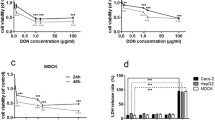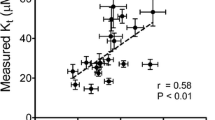Abstract
Recent studies have shown that Cd2+ has relatively specific damaging effects on cell-cell junctions in the renal epithelial cell line, LLC-PK1. The objective of the present studies was to examine the surface binding and uptake of Cd2+ by LLC-PK1 cells in relation to the disruption of cell-cell junctions. LLC-PK1 cells on Falcon Cell Culture Inserts were exposed to CdCl2 containing trace amounts of109Cd2+ from either the apical or the basolateral compartments, and the accumulation of109Cd2+ was monitored for up to 8 h. The integrity of cell-cell junctions was assessed by monitoring the transepithelial electrical resistance. The results showed that the cells accumulated 3–4 times more Cd2+ from the basolateral compartment than from the apical compartment. The accumulation of Cd2+ from the basolateral compartment occurred in two phases: a rapid, exponential phase that occurred in 1–2 h and coincided with a decrease in transepithelial resistance, and a slower, linear phase that continued for 6–8 h. The Cd2+ that accumulated during the rapid phase was easily removed by washing the cells in EGTA, indicating that most of it was bound to sites on the cell surface. By contrast, most of the Cd2+ that accumulated during the slower phase could not be removed by EGTA, indicating that it had been taken up by the cells. Additional studies showed that the rapid phase of Cd2+ accumulation was enhanced when Ca2+ was present at low concentrations (0.1 mM), and was greatly reduced when Ca2+ was present at high concentrations (10 mM). These results suggest that Cd2+ damages the junctions between LLC-PK1 cells by interacting with Ca2+-sensitive sites on the basolateral cell surface.
Similar content being viewed by others
References
Åkerman EO, Honkaniemi J, Scott IG, Andersson LC (1985) Interaction of Cd2+ with the calmodulin-activated (Ca2++Mg2+)-ATPase activity of human erythrocyte ghosts. Biochem Biophys Acta 845: 48–53
Blazka ME, Shaikh ZA (1991) Differences in cadmium and mercury uptakes by hepatocytes: role of calcium channels. Toxicol Appl Pharmacol 110: 355–363
Boller K, Vestweber D, Kemler R (1985) Cell adhesion molecule uvomorulin is localized in the intermediate junctions of adult intestinal epithelial cells. J Cell Biol 100: 327–332
Bruggerman IM, Van Bladeren PJ, Temmink JHM (1990) Transport and toxicity of CdCl2 in LLC-PK1 cells. Toxicol Lett 53: 167–168
Bruggerman IM, Temmink JHM, Van Bladeren PJ (1992) Effect of glutathione and cysteine on apical and basolateral uptake and toxicity of CdCl2 in kidney cells (LLC-PK1). Toxicol In Vitro 6: 195–200
Chao SH, Suzuki Y, Zysk JR, Cheung WY (1984) Activation of calmodulin by various metal cations as a function of ionic radius. Mol Pharmacol 26: 75–82
Elinder CG, Kjellström T (1986) Carcinogenic and mutagenic effects. In: Friberg L, Elinder C-G, Kjellstrom T, Nordberg GF (eds) Cadmium and health: a toxicological and epidemiological appraisal. Vol 2 CRC Press, Boca Raton, Fl, pp 205–229
Felley-Bosco E, Diezi J (1991) Cadmium uptake and induction of metallothionein synthesis in a renal epithelial cell line (LLC-PK1). Arch Toxicol 65: 160–163
Flanagan JL, Friedman PA (1991) Parathyroid hormone-stimulated cadmium accumulation in Madin-Darby canine kidney cells. Toxicol Appl Pharmacol 109: 241–250
Foulkes EC (1985) Interaction between metals in rat jejunum: implications on the nature of cadmium uptake. Toxicology 37: 117–125
Foulkes EC (1986) Handbook of Experimental Pharmacology, Vol 80. Springer-Verlag, New York
Foulkes EC (1988) On the mechanism of transfer of heavy metals across cell membranes. Toxicology 52: 263–272
Foulkes EC, Blanck S (1990) Acute cadmium uptake by rabbit kidneys: mechanisms and effect. Toxicol Appl Pharmacol 102: 464–473
Friberg L, Elinder C-G, Kjellström T, Nordberg G (1986) Cadmium and health: a toxicological and epidemiological appraisal, Vol 1–2. CRC Press, Inc., Boca Raton, FL
Goyer RA, Miller CR, Zhu SY, Victery W (1989) Non-metallothionein-bound cadmium in the pathogenesis of cadmium nephrotoxicity in the rat. Toxicol Appl Pharmacol 101: 232–244
Gstraunthaler G, Steinmassl D, Pfaller W (1990) Renal cell cultures: a tool for studying tubular function and nephrotoxicity. Toxicol Lett 53: 1–7
Gumbiner B, Simons K (1986) A functional assay for proteins involved in establishing an epithelial occluding barrier: identification of a uvomorulin-like polypeptide. J Cell Biol 102: 457–468
Hinkle PM, Kinsella PA, Osterhoundt KC (1987) Cadmium uptake and toxicity via voltage-sensitive calcium channels. J Biol Chem 262: 16333–16337
Hull RN, Cherry WR, Weaver GW (1976) The origin and characteristics of a pig kidney cell strain, LLC-PK1. In Vitro 12: 670–677
Lasheras C, Scott J, Rabito C (1988) Na+-Sugar cotransport system as a polarization marker during organization of epithelial membrane. Am J Physiol 255: C745-C753
Mazzei GJ, Girrard PR, Kuo JF (1984) Environmental pollutant Cd2+ biphasically and differentially regulates myosin light chain kinase and phospholipid Ca2+-dependent protein kinase. FEBS Lett 173: 124–128
Mitchell DB, Santone KS, Acosta D (1980) Evaluation of cytotoxicity in cultured cells by enzyme leakage. J Tiss Cult Meth 6: 113–116
Morselt AFW (1991) Environmental pollutants and disease: a cell biological approach using chronic cadmium exposure in the animal model as a paradigm case. Toxicology 70: 1–84
Mullin JM, O'Brien TG (1986) Effects of tumor promoters on (LLC-PK1) renal epithelial tight junctions and transepithelial fluxes. Am J Physiol (Cell Physiology) 251: C597–602
Mullin JM, Weibel J, Diamond L, Kleinzeller A (1980) Sugar transport in the LLC-PK1 renal epithelial cell line: similarity to mammalian kidney and the influence of cell density. J Cell Physiol 104: 375–389
Nath R, Prasad R, Palinal VK, Chopra RK (1986) Molecular basis of cadmium toxicity. Prog Food Nutr Sci 8: 109–163
Nolan CV, Shaikh ZH (1986) The vascular endothelium as a target tissue in acute cadmium toxicity. Life Sci 39: 1403–1409
Ozawa M, Engel J, Kemler R (1990) Single amino acid substitutions in one Ca2+ binding site of uvomorulin abolish the adhesive function. Cell 63: 1033–1038
Prentice RC, Hawley PL, Glonek T, Kopp SJ (1984) Calcium-dependent effects of cadmium on energy metabolism and function of perfused rat heart. Toxicol Appl Pharmacol 75: 198–210
Prozialeck WC, Niewenhuis RJ (1991a) Cadmium (Cd2+) disrupts intercellular junctions and actin filaments in LLC-PK1 cells. Toxicol Appl Pharmacol 107: 81–97
Prozialeck WC, Niewenhuis RJ (1991b) Cadmium (Cd2+) disrupts Ca2+-dependent cell-cell junctions and alters the pattern of E-cadherin immunofluorescence in LLC-PK1 cells. Biochem Biophys Res Commun 181: 1118–1123
Rabito CA (1986) Occluding junction in a renal cell line (LLC-PK1) with characteristics of proximal tubular cells. Am J Physiol (Renal Fluid Electrolyte Physiology 19) 250: F734–743
Ringwald M, Schuh R, Vestwever D, Eistetter H, Lottspeich F, Engel J, Dolz R, Jahnig F, Epplen J, Mayer S, Muller C, Kemler R (1987) The structure of cell adhesion molecule uvomorulin. Insights into the molecular mechanisms of Ca2+-dependent cell adhesion. EMBO J 6: 3647–3653
Schaeffer VH, Stevens JL (1987) The transport of S-cysteine conjugates in LLC-PK1 cells and its role in toxicity. Mol Pharmacol 31: 506–512
Takeichi M (1990) Cadherins: a molecular family important in selective cell-cell adhesion. Annu Rev Biochem 59: 237–252
Templeton DM (1990) Cadmium uptake by cells of renal origin. J Biol Chem 265: 21764–21770
Author information
Authors and Affiliations
Rights and permissions
About this article
Cite this article
Prozialeck, W.C., Lamar, P.C. Surface binding and uptake of cadmium (Cd2+) by LLC-PK1 cells on permeable membrane supports. Arch Toxicol 67, 113–119 (1993). https://doi.org/10.1007/BF01973681
Received:
Accepted:
Issue Date:
DOI: https://doi.org/10.1007/BF01973681




